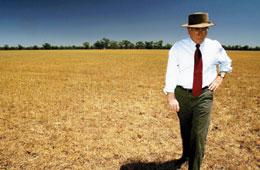 I. WALDIE/GETTY IMAGES
I. WALDIE/GETTY IMAGESAny campaign veteran will tell you that voters are fickle, switching from candidate to candidate and issue to issue as the whim takes them. But in Australia, voters may have changed their minds once and for all on the issue of climate change. In mid-2006, something seemed to shift climate from an 'issue of concern' to the top of the list of people's most serious considerations.
Frank Muller, an expert on sustainability policy at the University of New South Wales in Sydney, recalls that the change took place while he was on a four-month visit to America last year. “I went to the United States in June and was back in October, and in that period, this big switch had taken place,” he says. Others pinpoint it even more precisely. “I think in about September of last year there was a global shift in awareness of this issue,” says Tim Flannery, a zoologist at Macquarie University in Sydney who won this year's Australian of the Year award for his climate activism.
Blame any number of factors for the switch: Al Gore's visit to Australia in September 2006 (and Prime Minister John Howard's refusal to meet with him); the October 2006 release of Nicholas Stern's review of the economics of climate change, which estimated vast costs if global warming is not stemmed soon; and, looming over all, the drought that is plaguing Australia, by some measures the worst in a century or more.
The timing could not be worse for Howard (pictured above), the Liberal prime minister who has led Australia for 11 years and is behind in opinion polls in his quest for a fifth term in office. On 24 November, Howard will face his Labor opponent, Kevin Rudd, in a federal election to determine who will form the next national government. And climate is shaping up as a major election issue. One of Howard's defining foreign-policy stances has been his refusal to ratify the Kyoto Protocol to control greenhouse-gas emissions; Rudd has vowed to ratify it immediately if elected.
“In their minds, Australians are linking the drought to the longer-term issue of climate change.”
As the election date draws closer, both parties have released a slew of climate-related policies and promises in an effort to woo voters. They range from Rudd's Aus$200-million (US$185-million) plan to save the Great Barrier Reef, to Howard's vow to ratify an international agreement to replace Kyoto after it expires in 2012 — that is, as long as the agreement applies to major emitters such as China and India.
What happens in Australia's election could shape the international dynamics on climate change for years to come. A week afterwards, representatives will gather in neighbouring Bali to start thrashing out details of a post-Kyoto strategy for limiting emissions (see page 319). A change in Australian leadership could bolster morale, if not much else, among the delegates. And with a presidential election due the following November in the United States (see page 340), some envisage a not-so-distant future in which the leaders of the two major countries that did not ratify Kyoto are instead in favour of mandatory reductions in greenhouse gases.
For Australians, the potential consequences of climate change have been driven home by the country's water crisis. The five-year drought, often described as the worst in living memory, has left rural communities in the southeast of the country reeling and many urban areas with severe water shortages. Average annual inflows into Sydney's dams for the period 1991–2006, for instance, were 71% less than for 1948–1990.
The drought is hitting home in many parts of the country, says Mike Young, professor of water economics and management at the University of Adelaide. “People are looking at water shortages,” he says, “and farmers are finding that their water entitlements have been dramatically debased.” Young says that in their minds, Australians are linking the drought to the longer-term issue of climate change.
Opinion polls bear that out. In August, a poll conducted by the Lowy Institute for International Policy, a Sydney-based think-tank, suggested that climate change ranks ahead of nuclear weapons, Islamic fundamentalism and international terrorism as the external threat most Australians are concerned about. And earlier this month, the Climate Institute in Sydney commissioned a poll of 877 voters in 9 key marginal electorates. It found that 73% of voters thought climate change would have either a strong or a very strong influence on their vote at the election, an increase from 62% in August.
All change
Howard's anti-Kyoto stance did not prevent him from being re-elected in 1998, 2001 and 2004. But that may be about to change. Although Australians aren't likely to cast their vote solely on the basis of climate-change policies, the divergent positions of Howard and Rudd are becoming a major force in the current election campaign, says veteran pollster David Briggs from Galaxy Research in Sydney.
“It is one of those areas where Rudd has been able to extract some point of difference,” says Briggs. “It does make a contribution to the perception that Rudd is the man of the future, and that he has a vision for the future that includes proper environmental planning, whereas John Howard is a man of the past.”
For much of his time in office, Howard has questioned the scientific basis of anthropogenic climate change, says Peter van Onselen, a political scientist at Edith Cowan University in Perth and co-author of a biography on the prime minister. “He was comfortably within the category of being a climate-change sceptic,” van Onselen says. “He felt that the science on it, at least what was presented to him, went both ways as to the significance of it or not.”
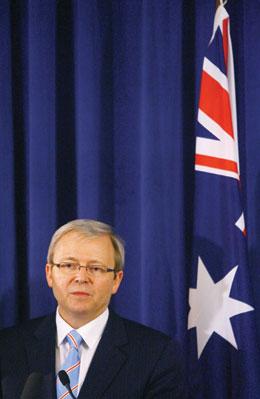 Kevin Rudd wants to ratify the Kyoto Protocol.M. NOLAN/GETTY IMAGES
Kevin Rudd wants to ratify the Kyoto Protocol.M. NOLAN/GETTY IMAGESGuy Pearse, a former speechwriter for Robert Hill, one of Howard's previous environment ministers, argues that the prime minister's perspective was heavily influenced by Australia's mining and energy sectors. Pearse's book High & Drydetails, on the basis of interviews with key players in the country's greenhouse-gas policies, what he calls the 'greenhouse mafia'. According to Pearse, lobbyists and advisers from industry groups sold Howard the idea that Australia's economy rests on the supply of cheap fossil fuels. Their message, he says, was simple: “When it all boils down, it's about avoiding cuts in Australia's emissions for as long as possible, delaying as long as possible.”
But even within Howard's cabinet, there has been dissent on the subject of climate. In late October, the Australian Financial Reviewbroke a story that Howard's environment minister, Malcolm Turnbull, had six weeks earlier failed in his attempt to convince the cabinet to ratify the Kyoto agreement. Howard has not denied the charge, and Turnbull has not spoken publicly about it.
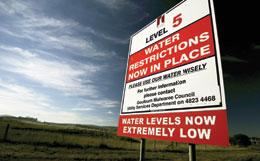 Water restrictions have brought the issue of climate change to the fore.I. WALDIE/GETTY IMAGES
Water restrictions have brought the issue of climate change to the fore.I. WALDIE/GETTY IMAGESAnalysts agree that Howard tends to view the issue of climate change through the prism of economics. Like US President George W. Bush, Howard has long said that he thinks mandatory emissions reductions could hurt his country's economic growth, and that excluding developing countries such as China from the agreement would hurt Australia competitively. This came to the forefront in 2002, when Howard decided not to ratify the Kyoto Protocol, despite having signed it.
Clean green
In place of mandatory emissions reductions, Howard opted for several clean-energy initiatives. In June 2004, for instance, his Liberal–National coalition government announced a new policy called Securing Australia's Energy Future. It includes a Aus$500-million fund to encourage the energy sector to develop lower-emission technologies, and Aus$75 million targeted at solar-energy projects. Four months later, Howard was re-elected.
Environmental groups have criticized Howard's continuing focus on fossil fuels. According to the Australian Bureau of Agricultural and Resource Economics, in 2004–05, 93% of the country's electricity was generated from fossil fuels (coal, oil and gas), and 7% from renewables such as hydroelectricity, wind, biomass and biogas. That could have something to do with the nation's 73-billion-tonne coal deposits, found mostly in New South Wales and Queensland. Coal also forms the backbone of a robust trade with nearby China. “Whatever may be the merits of renewables,” Howard told ABC radio in 2004, “the reality is that the older fuels of which we have large supplies are going to contribute the bulk of our energy needs and what we have to do is to make them cleaner.” Hence his government's focus on emphasizing clean-coal technologies, such as carbon capture and sequestration, and on nuclear power as an alternative low-emission energy source in the future.
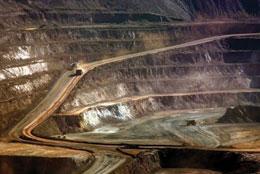 Australia's wealth of coal has made developing alternative energy sources a relatively low priority.I. MUNRO/NEWSPIX
Australia's wealth of coal has made developing alternative energy sources a relatively low priority.I. MUNRO/NEWSPIXThe Howard government has made several major, if criticized, initiatives in the field of climate. In 2005, Howard took Australia into the Asia–Pacific Partnership on Clean Development and Climate, a non-binding partnership established with China, India, Japan, South Korea and the United States to foster cooperation on climate-change action. Australia pledged Aus$100 million to the group over five years, from which it has so far allocated Aus$60 million to 44 projects. These include deployment of high-efficiency solar-power stations, improved efficiency standards for appliances and a mobile system that can test carbon capture at coal-fired power stations.
In June 2007, Howard announced that the government would introduce a cap-and-trade emissions-trading scheme, which observers consider his most significant backflip on climate-change policy in the lead-up to the election.
And in September, Howard placed climate change on the agenda for a meeting of the Asia–Pacific Economic Cooperation (APEC) forum, which includes the United States, China, Russia and Japan. Without setting any hard targets, the APEC leaders signed up to a statement, which said they agreed “to work to achieve a common understanding on a long-term aspirational global emissions reduction goal to pave the way for an effective post-2012 international arrangement”.
Conservative approach
The question for many observers is whether such actions will be enough to make a difference. In the run-up to the elections, Australian climate scientists are cautious about seeming overly partisan, and even the outspoken Flannery is reticent about openly criticizing any political party. But if pressed, he notes that Howard's climate announcements lack teeth. “If you add up all of those policies, all of the pronouncements,” he says, “they make no difference in terms of emissions.”
In 2005, greenhouse-gas emissions in Australia reached 559 million tonnes of carbon dioxide equivalent, which is 2% higher than 1990 levels. Government figures show that per capita emissions fell between 1990 and 2005, from 32.3 to 27.6 tonnes of carbon dioxide equivalent — but they remain the second highest in the developed world, after Luxembourg.
“Have current policies put us on the right track? The answer is clearly no.”
Dave Griggs
Dave Griggs, a climate scientist at Monash University in Melbourne and former head of the science working group secretariat of the Intergovernmental Panel on Climate Change (IPCC), argues that Australia's position in the ranks is not acceptable. “The IPCC fourth assessment report is very clear that we need to mitigate greenhouse-gas emissions by a very large fraction,” he says. “I don't see that the policies that have been put in place to date have been aiming to get an Australian economy in which emissions have gone down to a level that is probably required globally. Have current policies put us on the right track? The answer is clearly no.”
Climate is, of course, just one issue facing voters in the upcoming elections; the Howard and Rudd campaigns have also included ongoing concerns such as the economy, health care and taxation. For some, the prominence of climate echoes previous elections in which environmental issues played a role. In 1983 for example, a controversial proposal to dam a Tasmanian river helped to bring down the government of Malcolm Fraser. In the upcoming election, “the difference between the major parties over whether or not to ratify the Kyoto Protocol is as sharp as the difference in 1983 over the Franklin dam”, says Muller.
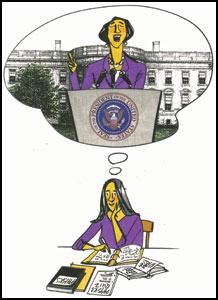 See also our Climate politics special, and take the quiz: What every president should knowM-H Jeeves
See also our Climate politics special, and take the quiz: What every president should knowM-H JeevesBefore the election was called, for example, the Howard government committed to ensuring that about 15% of Australia's electricity would come from low-emission sources by 2020. It also launched a taxpayer-funded advertising campaign, featuring television commercials that focused on simple things families could do to reduce their greenhouse footprint, such as drying clothes on a washing line or switching to compact fluorescent lights (incandescent bulbs are being phased out entirely across the country).
Power and the passion
Both parties have also opted for charismatic, high-profile figures as their environment representatives. In the case of the Labor party, the candidate is Peter Garrett, who was the front man for the rock group Midnight Oil and former president of the advocacy group Australian Conservation Foundation in Melbourne. The government's choice for environment minister is Turnbull, the minister who reportedly argued for ratifying Kyoto.
Howard and Rudd themselves have focused on climate change at key moments. During the only televised debate between them in the campaign, on 21 October, Howard chose climate change for one of two new policy announcements (the other being on troops in Iraq). He vowed to establish a fund to pay for development of clean energy and to compensate low-income earners for hikes in power costs, funded by the revenue raised by auctioning emissions permits.
For his part, Rudd made a point of reminding voters that his party had set a concrete target for a 60% reduction in emissions from 2000 levels by 2050. The Labor party has, however, refused to commit to a target for 2020 until after it receives an economic report it commissioned on climate change from Ross Garnaut from the Australian National University in Canberra.
ADVERTISEMENT
Last month, the Australian Conservation Foundation released an election scorecard designed to compare the parties on their approaches to climate change, sustainability and the environment. With four weeks to go, both parties scored poorly: Labor at 56%; Howard's coalition just 21%.
All this leads some commentators to despair about whether the election can truly turn around the major climate issues facing Australia. “We love to romanticize about a sunburnt country,” says Pearse, referring to the well-loved Australian poem My Country.“But people need to start realizing that what we're talking about is a country burnt beyond recognition in our lifetimes — and unless we start acting, that's what we're going to cop.”
Stephen Pincock is a writer based in Sydney.
